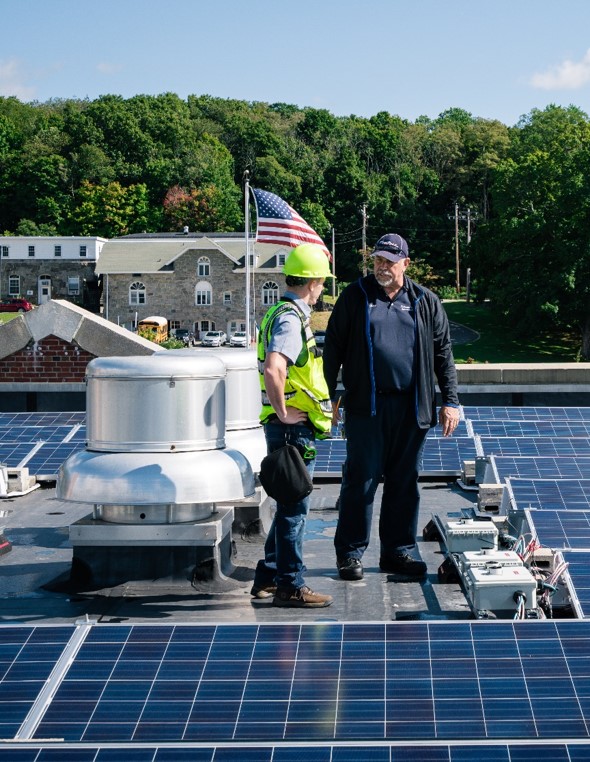Stepping Back to Move Forward: The benefits of community energy strategic planning
Community energy strategic planningis a crucial first step for cities and counties to reap rewards in today's changing energy landscape.
When making significant decisions in life, it's often wise to step back and take a look at the big picture to help assure you're taking the right course. This is especially true when many paths can be taken. Such is the case for local governments when it comes to energy-related opportunities. Cities and counties, big and small, are reaping the economic benefits by doing just that.
The Changing Grid
A radical change is underway when it comes to how electricity is produced, transmitted, distributed, and purchased by governments  and consumers in the United States. The U.S. electricity system has historically relied on centralized power generation, with long-distance transmission to local distribution systems delivering energy to customers. The American Society of Civil Engineers (ASCE) 2017 Infrastructure Report Card notes that most of the electric transmission and distribution lines, also known as the grid, are more than 50 years old, well beyond their life expectancy. The current grid is unable to meet today's electricity demand, especially when you factor in the growth of renewables like wind and solar. Extreme weather events have proven the grid to be highly vulnerable to disruptions. Further, only about one-third of the power produced at today's power plants reaches customers. In order to improve this system, ASCE's report indicates that $934 billion is needed over the next 10 years.
and consumers in the United States. The U.S. electricity system has historically relied on centralized power generation, with long-distance transmission to local distribution systems delivering energy to customers. The American Society of Civil Engineers (ASCE) 2017 Infrastructure Report Card notes that most of the electric transmission and distribution lines, also known as the grid, are more than 50 years old, well beyond their life expectancy. The current grid is unable to meet today's electricity demand, especially when you factor in the growth of renewables like wind and solar. Extreme weather events have proven the grid to be highly vulnerable to disruptions. Further, only about one-third of the power produced at today's power plants reaches customers. In order to improve this system, ASCE's report indicates that $934 billion is needed over the next 10 years.
Rather than continuing to pour money into this inefficient grid, innovative thinkers are looking to create a more distributed system; one that calls for action at the local level, and creates cost-saving and revenue-generating opportunities. In addition to reducing electricity demand through energy efficiency measures, local innovations include local power-producing projects such as gas turbine generators, private solar installations, as well as community-based energy solutions like community solar, electric-vehicle systems, smart meters, and microgrids.
Investing in Energy
Despite consistent and increasing investment in energy efficiency and other energy strategies, the potential to reap economic and other benefits from these projects remains huge. The International Energy Agency's 2016 Energy Efficiency Market Reportindicates that, while the U.S. invested over $6 billion dollars in energy efficiency in 2015, fully two-thirds of the market potential for energy efficiency is still up for grabs. The global energy efficiency market alone is expected to grow to $30 billion annually by 2028. A 2013 U.S. Department of Energy (DOE) market analysis found that 70 percent of state and local governments had not taken advantage of existing opportunities. This doesn't even include the benefits associated with renewable energy projects.
Before leaping toward any one of these opportunities, however, it's vital for communities to know how energy is being used, the resources and data required for each opportunity, and how they are related. This information allows them to prioritize and plan efficiently.
Community Energy Strategic Planning
The DOE's Guide to Community Energy Strategic Planning(CESP)is widely accepted as the best practice for these purposes. CESP's emphasis on the role of the leadership team, and engagement of community stakeholders, aligns with the administrative and outreach efforts required for most energy projects. It also provides insight into how strategies could be combined to minimize costs and optimize benefits.
The process may sound daunting, but it helps communities gain the insight necessary to pursue the most beneficial activities, reduce the burdens associated with entering the energy market, and invest in infrastructure and public programs. The DOE confirms that, "in a time of tightening budgets ... developing a Strategic Energy Plan can be an important component of good governance, and it can also put governments in a prime position to capture funding opportunities as they arise, because they have proactively identified their goals and priority actions."

Community Energy in Action
The following communities are taking this step back to move forward confidently:
- Frederick County, Maryland,completed its Comprehensive Energy Plan in 2010, and achieved $358,000 in energy savings through building projects and vehicle fuel conservation in 2011 alone.
- Following the guidance laid out in its 2010 Community Strategic Energy Plan,Arlington County, Virginia has built 32 energy-saving "green buildings." Using strategies that included LED lighting, increased insulation, and high-performance heating and cooling equipment; the equivalent of energy used in 1,600 homes has been saved, as of 2016.
- The City of Rochester, New York,completed an Energy Plan in January 2015, and has prioritized lighting retrofit projects. In its first round of projects (in which T8 fluorescents were replaced with LED) Rochester yielded $231,000 in annual savings. A recently announced $840,000 grant from New York State will support replacing lights in 17 community centers and three municipal facilities, which will yield another $90,000 in annual savings.
- A building energy analysis inBoise, Idaho,as part of their 2017 Community Strategic Energy Management efforts, led to a sharing of design best practices across locations, and awareness of the 17 buildings that consumed 70 percent of the City's energy. This included fire stations that will benefit from design upgrades.
- The City of Denton, Texas,2012 Sustainability Plan has helped the city reduce its greenhouse gas emissions by 20 percent from its 2006 baseline, with 45 percent of city customers receiving power from renewable sources.
These studies allowed the pursuit of projects, many of which were supported by grant dollars made available because they analyzed the opportunity, and were able to show the resulting energy and greenhouse gas reduction. In addition to the economic benefits, many of these communities have shown gains in:
- Job creation for the local economy
- Greater energy security, and influence over energy choices
- A cleaner environment, and increased livability
- Improved communication across leadership and with the community, that will enhance other local government efforts
There are many ways to start your strategic energy planning process, and many resources available to help you. A visit to the DOE's Community Energy Strategic Planning site is a great first step. By taking a step back to move forward on energy projects, your community will unlock savings and give you a view to a landscape of economic and other opportunities.

Jeffrey Domanski is Senior Manager, Energy, Sustainability and Resilience at IBTS.He focuses on energy planning, professional education, and training programs, in addition to municipal toolkit and engagement platform services. Prior to joining IBTS, he was director of sustainability and energy at Courtney Strong Inc., director of sustainability strategies at Cushman & Wakefield, and co-director of sustainability at Princeton University. Mr. Domanski serves as a committee member on the Council of State Government's (CSG's) Energy and Environmental Public Policy Committee and was selected to serve on the board of the Upstate NY chapter of the U.S. Green Building Council (USGBC).
IBTS is a 501(c)(3) non-profit organization that works to build resilient communities by reducing risk, enhancing public safety, and improving quality of life. Services include: Building and Community Development, Energy and Sustainability Services, Disaster Planning and Recovery, Quality Assurance, as well as Compliance and Risk Monitoring. IBTS's work is guided by a Board of Directors made up of government officials appointed by state and local governmental associations, including the Council of State Governments (CSG), International City/County Management Association (ICMA), National Association of Counties (NACo), National Governors Association Center for Best Practices (NGA Center), and National League of Cities (NLC).
IBTS | www.ibts.org
Volume: 2018 July/August











.png?r=3785)
